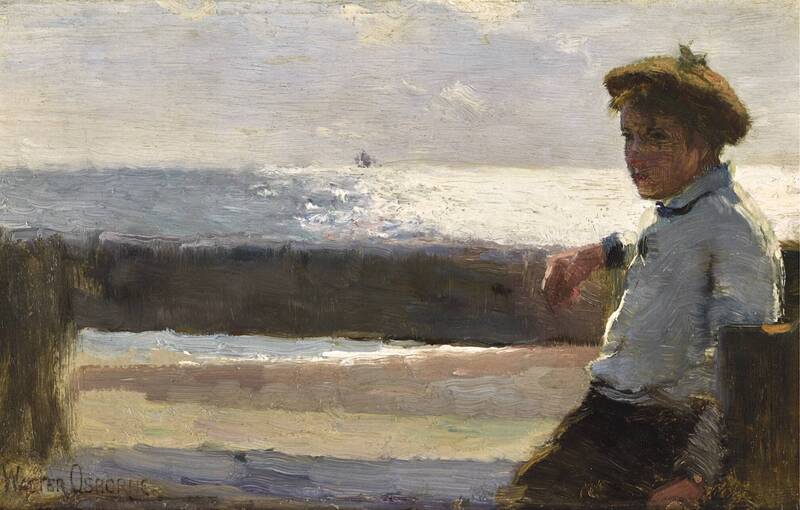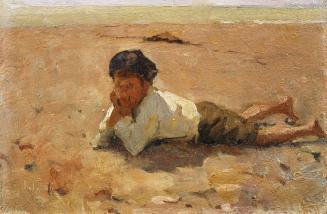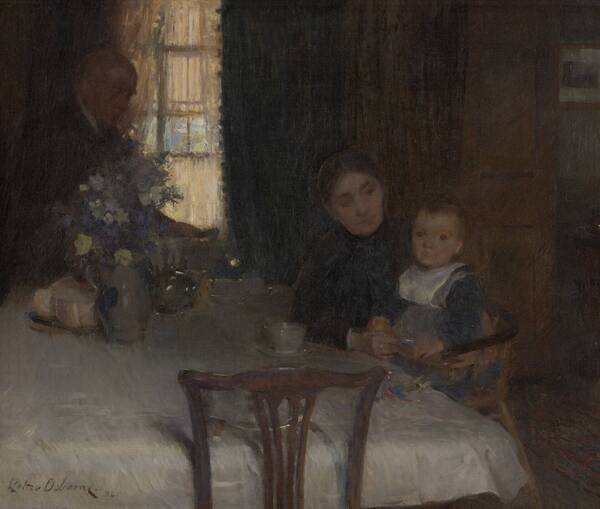Seated Boy and Sea

Walter Frederick Osborne (Irish, 1859-1903)
Walter Frederick Osborne (Irish, 1859-1903), Seated Boy and Sea, c. 1884-6, oil on board, 5½ x 8¾ in. (14 x 22 cm). The O’Brien Collection.
Walter Osborne was one of Ireland’s most important nineteenth-century painters. He trained at the Royal Hibernian Academy in Dublin and the Royal Academy of Fine Arts in Antwerp. As a young artist, he travelled extensively through the French and Flemish countryside, absorbing new lessons in landscape painting inspired by the French naturalist painter Jules Bastien-Lepage. By 1884, he had returned to Dublin, where he lived during the winter. In the warmer summer months, he travelled around the English countryside painting scenes of rural life.
Osborne travelled with small panels or boards like this one, ready to capture fugitive effects of light and atmosphere while painting en plein air. Here, he is paying particular attention to how light shines on the sea and the figure of the boy. Look at the way the boy is silhouetted by the sunlight behind him. Light envelops his figure from both sides but leaves his face in relative shadow. Notice too Osborne’s focus on how sunlight shines off and through skin. We see this on the boy’s hand, where light reflects differently off the back and tips of his fingers. There is even a glow of red paint at the bottom of the boy’s nose showing light passing through the skin of his nostrils.
Oil studies were most often used by artists as preparatory works for larger compositions. But we can tell here that Osborne took care to make this painting a pleasing and carefully finished final product. In addition to his focus on light, Osborne has paid close attention to the work’s composition. Taking advantage of the dimensions of his panel, Osborne has split his composition into horizontal bands of color—sky, sea, wood, sand, and shadow—all balanced by the vertical shapes of the fence posts and the boy himself. The boat on the far horizon adds a spot of visual interest in the center of the work, drawing our gaze out to sea. In contrast, the boy looks away from the water. What has caught his eye?
The date of this study is unknown but may coincide with Osborne’s sketching trips to Walberswick in Suffolk, which the artist visited from 1884 to 1886. There, Osborne painted a figure leaning against a similar looking pier in An October Morning (1885), one of his most famous early works. He also made studies of children on the beach, including a boy wearing a felt hat painted in Walberswick in 1886. Jeanne Sheehy describes an oil study titled Boy on Seashore, painted c. 1885, that may be this work (Sheehy 1974, #111).
Osborne was proud of his oil studies and often exhibited and sold them. This work was kept in the family. In 1990, it was owned by Sophia Mallin, the stepsister of Violet Stockley, Osborne’s niece. You can see Violet as a young girl in another painting by Osborne at the Snite Museum of Art called At the Breakfast Table (1894).
Judith Stapleton, February 2023.
Donald and Marilyn Keough Curatorial Fellow
Snite Museum of Art, University of Notre Dame
Walter Frederick Osborne, An October Morning, 1885, oil on canvas, 71 x 91 cm, Guildhall Art Gallery, London. Photo credit: City of London Corporation and ArtUK, https://artuk.org/discover/artworks/an-october-morning-51166.


Walter Frederick Osborne, Boy on Shore, 1886, oil on board, 15.3 x 22.8 cm, Hugh Lane Gallery. Photo credit: Dublin City Gallery The Hugh Lane, https://hughlane.emuseum.com/objects/1571/boy-on-shore.
Walter Frederick Osborne, At the Breakfast Table, 1894, oil on canvas, 20 x 24 in. (50.8 x 60.96 cm), Snite Museum of Art, IN. Donald and Marilyn Keough Foundation Fund. Photo credit: Snite Museum of Art, https://marble.nd.edu/item/2019.029.

Exhibited:
Gorry Gallery, Dublin, An Exhibition of 18th,19th, and 20th Century Irish Paintings, 27 September – 10 October 1991, no. 18.
Boston College Museum of Art, America’s Eye: Irish Paintings from the Collection of Brian P. Burns, 26 January - 19 May 1996, no. 34, illustrated p. 1204
John F. Kennedy Center, Washington, D. C., Irish Paintings from the Collection of Brian P. Burns, 13 - 28 May 2000, illustrated p. 83
Phoenix Art Museum, A Century of Irish Painting: Selections from the Brian P. Burns Collection, 3 March - 29 April 2007, illustrated p. 91
The Hunt Museum, Limerick, Lavery and Osborne: Observing Life, 2019, illustrated pp. 90-91
“Poetic and Musical reflection by Marty Fahey”
Poetic reflection:
The sea green and grey that day.
She told me two or three frightening things
which had happened to her over the years,
and one sad thing. I do not know
if the sea helped or if I helped
but something got transferred. Later,
over tea, she said, "Now you know."
The middle of any story is always missing.
Little boy blue becomes old man blue.
Fin d'histoire.
"THE BEACH, MALAHIDE" by Richard Halperin
Musical reflection:
Port na bPúcaí
Muireann Nic Amhlaoibh & Billy Mag Fhloinn
The Fairy Tune from The Blasket Islands, Co. Kerry. A fisherman heard this music on the wind one night and played it on his fiddle. The words tell the story of a woman captured by the fairies.
https://www.youtube.com/watch?v=8C5QqFapcuw